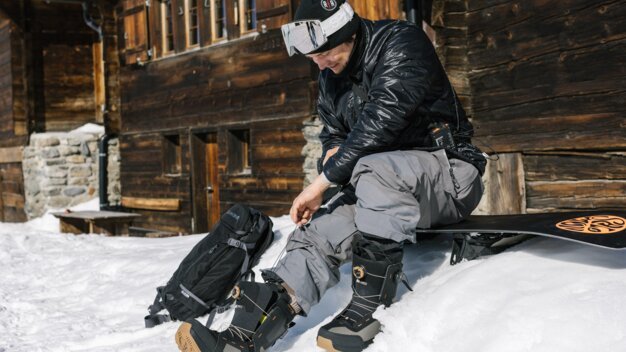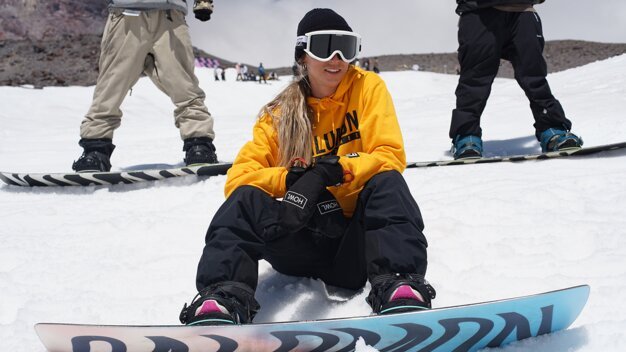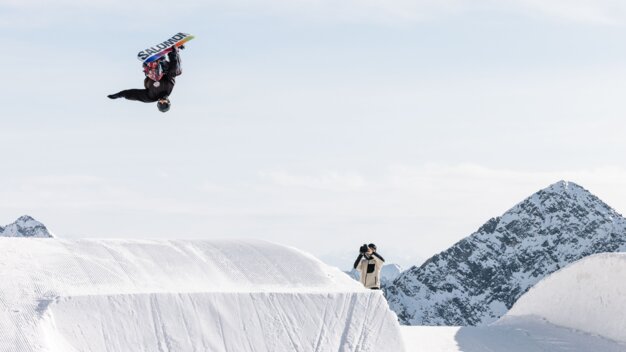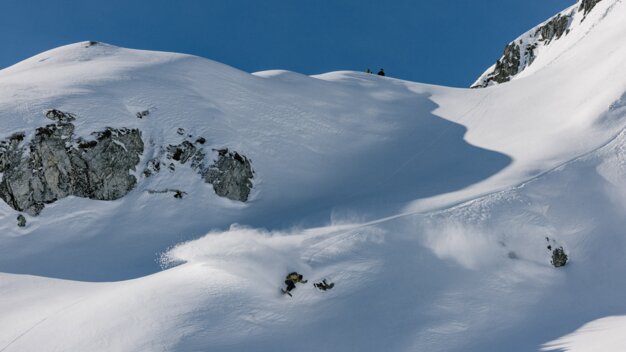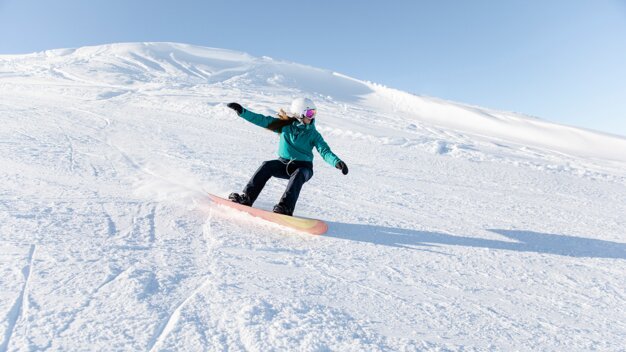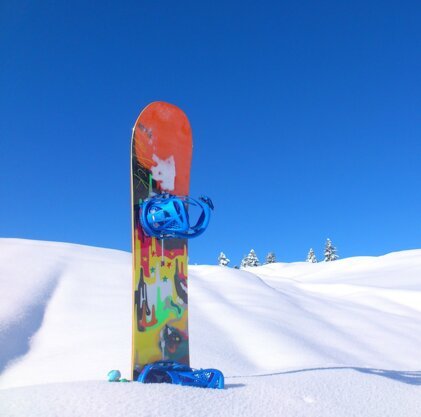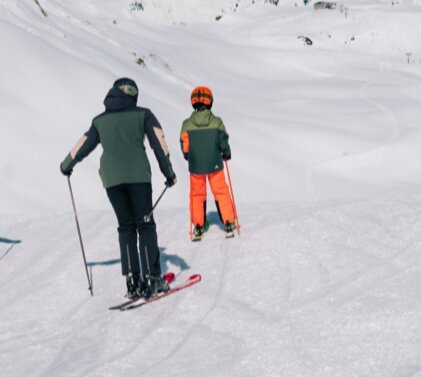
You've finally got your new snowboard in your hands. The excitement is great and you want to hit the slopes right away. But before you grab your gear, you need to adjust your snowboard bindings properly. With the tips and tricks from the snowboard experts at INTERSPORT Rent, this is very easy. Let’s have a go at it.
Adjusting snowboard bindings: This is how it works
First things first: There is no right or wrong way to adjust snowboard bindings. A lot depends on the rider, his or her physical characteristics and riding style in order to optimally fit and adjust the binding. And this applies regardless of whether you hit the park, snorkel through some deep powder or practice your carving turns on the slope. Therefore, the adjusted bindings should ideally also match the character of your board.
Snowboard binding setup: What is the stance and how do I set it?
Just to remind you before we start: Adjusting the snowboard binding is the same for men and women. The only thing that counts is your intention with the board. Park, slope, powder – anything is possible. And the right mounting and the right settings will support your riding. Let's get going.
The binding is adjusted in two steps:
- Mount the binding on the snowboard.
- Goofy vs. Regular
- Stand width
- Binding offset (stance setback)
- Binding angle
- Adapt the binding to your boots and adjust it correctly.
Within our step-by-step-guideline you'll come across the term stance, which is commonly used quite loosely. Usually, it refers directly to your position on the board and all the aspects that goes with it. And for the next few steps, we'll be looking at stance in various forms.
Tip: On new snowboards, the "reference stance" is usually indicated by a mark on the second and fourth screw hole. Manufacturers generally recommend this classic position for snowboard beginners and all those who enjoy travelling on different terrains (all-mountain riders).
Which foot in front and what does Goofy or Regular mean?
In the shop, our RENTertainers often ask you about Goofy or Regular at the beginning. They are not trying to put your Disney expertise to the test. Both terms stand for different positions on the board. Or to put it more simply: Which foot is in front when riding?
- Goofy: The right foot is at the front.
The right binding is positioned at the nose (front), the left at the tail (back). - Regular: The left foot is in front.
The left (front) binding goes on the nose side, the right (back) binding on the tail side.
Tip: If you don't yet know how you stand on the board, the famous "push test" can give you an idea. Have someone push you forwards unexpectedly. The foot that you step on first is most likely the one that will later be at the front of the board.
If you have a skateboard to hand, you can also simply stand on it and push for a few metres. Depending on which position you feel safer in, you should adjust your bindings accordingly.
The stance width: Wide or narrow stance
As soon as you know which foot you will be standing with at the front, we determine the stance width. The stance is always measured from the centre of the front disc of your binding to the rear disc. In addition to your riding style, the length of your board is also decisive. A stance that is less than shoulder width is usually an exception and is only used in a few cases.
The rule of thumb is: A shoulder-width stance is comfortable for most riders.
Tip: If you spend a lot of time in the park, you usually prefer a relatively wide stance. This leads to more stability and ensures better balance on rails or when being launched over kickers.
Stance Setback: Binding offset measured from nose and tail
The offset, i.e. how far you mount your binding forwards or backwards from the centre point, depends on two things:
- Riding style
- Snowboard type
Let's take a look at the stance setback for different styles. Incidentally, the same rules apply for men and women when adjusting your snowboard bindings.
- Freestyle board: Centred (same distance between the respective binding and the nose and tail)
The central alignment makes it easier to ride backwards - the best conditions for a visit to the park! - Freeride board: Slight setback of 1 to 1.5 centimetres (place the binding slightly backwards from the centre of the board - towards the tail)
This position shifts the weight to the tail and provides therefore better flotation qualities in deep snow. - All-mountain board: Same or similar position as the freeride board.
Would you like to know more about the different types of snowboards? Then our general information about snowboards or our tips for buying your first snowboard!
Snowboard binding angle: How to set it up correctly
We are now directly working on the binding and on the disc. To determine the angle of your bindings on the snowboard, it is best to start with a neutral position – I.e. at 0 degrees. From there, turn slowly until you have found the right setting.
The degrees on the disc range usually from around minus 20 degrees to plus 20 degrees. You can therefore see exactly what position the binding is in.
Tip: As a beginner, it's best to stick to the neutral stance, which is ideal for simply riding forwards.
Depending on your riding style, there are a few special features when adjusting the angles. If you ever have the time, you should give it a go and play around with it.
For freestylers in the park:
Most people swear by the duck stance of their freestyle bindings. This means that the front binding is set at a positive angle and the rear binding at a negative angle. The front angle is often slightly steeper than the rear angle, creating a V-position. This is perfect for riding backwards as well as for tricks and turns because the weight is evenly distributed on the board.
Guide values: Around + 15 degrees at the front and - 15 degrees at the rear.
For freeriding:
As a freerider, you are well advised to use a slightly narrower stance. To do this, mount both bindings at a positive angle. This position allows you to exert better pressure on the edges during turns. In combination with a slight setback stance, this gives you the perfect setting for fantastic powder adventures.
Guide values: Maximum + 21 degrees at the front and + 9 degrees at the rear
For all-mountain riders:
If you don't want to specialise in one riding style, a moderate duck stance (see above) with a slight setback is the right choice for you. This gives you good edge grip, high stability and sufficient flexibility for tricks and deep powder turns.
Guide values: Around + 15 degrees at the front and between - 9 degrees and + 6 degrees at the rear
Once you have set the degrees, place the binding back on the board. Screw it to the disc in the holes you have previously determined on the snowboard!
Tip: Pack a small tool for adjusting the binding for your first attempts with the new board! This way you can make any necessary changes yourself on the mountain.
The finishing touches: Final adjustment of snowboard bindings with boots
All that’s left to do is adjusting your snowboard binding to your boots. After that, all that remains is to hope that there is enough snow.
To adjust the snowboard binding to the boots, proceed as follows:
- Stand with the boot in the binding.
- Centre the binding. Do this in such a way that the overhang at the heel edge is greater than that at the toe edge – approximately in a ratio of 2:1.
- Adjust the highback (backbone and rear part of the binding). Park skiers generally prefer a vertical position or a low forward lean. Freeriders and slope riders skiers favour a stronger forward lean. The highback is important for your grip and power transmission. For binding angles of more than +15 degrees, rotation makes sense. The highback should then be parallel to the heel edge.
- Adjust the straps. The straps (ankle and toe strap) should be centred on the boots for optimum pressure distribution when riding.
Do you need new boots? Then get some help in our article about snowboard boots!
Frequently asked questions about adjusting snowboard bindings:
What is the range of angles for adjusting snowboard bindings?
Many bindings cover the range from -20 to +20 degrees. However, this varies depending on the manufacturer - values from -15 to +30 degrees are also possible. The settings can vary depending on riding style, personal preference and the terrain.
While snowboarders who spend a lot of time in the park often favour a duck stance (positive front angle, negative rear angle), freeriders rely on positive binding angles at the front and rear.
How far apart should snowboard bindings be?
To begin with a shoulder-width stance is usually a good recommendation, as this offers good balance and control. However, the stance width can be adjusted depending on riding style and terrain. Snowboarders who ride in the park, for example, prefer a wider stance for better balance on rails.
Is it better if the nose of the snowboard is longer than the tail?
The stance setback depends on the riding style and snowboard type. While powder boards usually have a slight offset to the tail for better flotation, the stance setback on a board for some park laps is more centralised.
How do I know if I am a Goofy or a Regular?
The most common method is the push test. Don't be alarmed if the salesperson or a friend asks you to turn around for a second. A small (unprepared) push is usually enough for you to take a step forwards. The foot that you step on first is most likely the one that will be at the front of the board later: If you step on your right foot first, your stance is Goofy. If you step on your left foot first on, you’re Regular.
INTERSPORT Rent Tip
Have you adjusted your snowboard bindings and found the perfect stance? Congratulations! It's best to write down the angle settings and measurements right away! That way, you can quickly transfer your customised set-up if the binding needs to be removed during servicing.
Remember: Tighten all screws before you get on the snowboard and point your nose downhill. This is the only way to make sure that everything is in place when riding. Now you're ready for the slope, off-piste or some tricks in the park.
Related articles
You may also be interested in:
